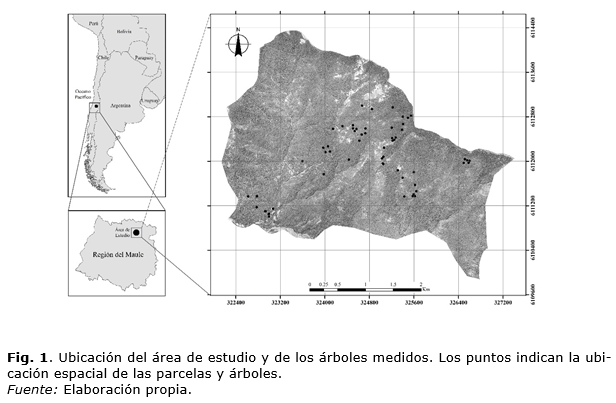Caracterización del diámetro, ángulo de inserción y longevidad de ramas vivas axiales de Nothofagus obliqua
Contenido principal del artículo
Resumen
El desconocimiento de la dinámica de crecimiento de la copa viva en los renovales de la especie Nothofagus obliqua limita fuertemente la objetiva formulación de esquemas silvícolas orientados a la producción de madera industrial de alta calidad. Por ello en este trabajo se describieron relaciones básicas existentes entre el tamaño, ángulo de inserción y edad de las ramas en el perfil fustal y algunas variables de la copa y del árbol. A una muestra de 59 árboles dominantes, distribuidos en distintas condiciones de edad, se le aplicó una técnica combinada de análisis de tallo, función de ahusamiento y mediciones de la rama más gruesa en cada decil de la altura total. Esto permitió determinar estrechas relaciones entre el diámetro, ángulo de inserción y la edad de la rama, así como con el tamaño y la edad de los árboles. Asimismo, las ramas más gruesas tendieron a tener ángulos de inserción menores, mayor edad, estar ubicadas en alturas relativas más bajas y estar insertas en secciones fustales de mayor diámetro. A partir de estas relaciones se posibilita la formulación de futuros modelos de predicción de ramas como herramientas para el desarrollo de esquemas silvícolas que se adapten a los diferentes requerimientos de calidad de la madera.
Descargas
Detalles del artículo
Citas
CHANGSHENG, L. et al. Crown morphology of Norway spruce from usual tree measurements. Journal of Forestry Research, 1998, 9(1), 8-12. ISSN: 1007-662X
COLIN, F. Y HOULLIER, F. Branchiness of Norway spruce in northeastern France: predicting the main crown characteristics from usual tree measurements. Annales des Sciences Forestières, 1992, 49(5), 511-538. ISSN: 1286-4560
CORVALÁN, P. Diagrama de manejo de la densidad de rodal para el control del tamaño de ramas basales en bosques septentrionales altoandinos dominados por roble en la región del Maule. Serie biomasa. Santiago, Chile: Facultad de Ciencias Forestales y de la Conservación de la Naturaleza, Universidad de Chile, 2015.
DONOSO, C. Bosques templados de Chile y Argentina. Variación, estructura y dinámica. Ecología Forestal. Santiago, Chile: Editorial Universitaria, 1993.
FORD, E. D. Branching, crown structure and the control of timber production. In Cannell MGR, JE Jackson eds. Attributes of trees as crop plants. Huntingdon, UK: Abbotts Ripton, Institute of Terrestrial Ecology, 1985.
GAJARDO, R. La vegetación natural de Chile. Clasificación y distribución geográfica. Santiago, Chile: Editorial Universitaria, 1994.
GARBER, S. Y MAGUIRE, D. Vertical trends in maximum branch diameter in two mixed-species spacing trials in the central Oregon Cascades. Canadian Journal of Forest Research, 2005, 35(2), 295-307. ISSN: 1208-6037
GROOT, A. y SCHNEIDER, R. Predicting maximum branch diameter from crown dimensions, stand characteristics and tree species. The Forestry Chronicle, 2011, 87(4), 542-551.
GROSSE, H. Y QUIROZ, I. Silvicultura de los bosques de segundo crecimiento de roble, raulí y coigüe en la región centro-sur de Chile. In C. Donoso, A. Lara eds. Silvicultura de los Bosques Nativos de Chile. Santiago, Chile: Editorial Universitaria, 1999. p. 95-128.
GSPALTL, M. et al. Leaf area and light use efficiency patterns of Norway spruce under different thinning regimes and age classes. Forest Ecology and Management, 2013, 288, 49-59.
ISHII, H. Y WILSON, M. E. Crown structure of old-growth Douglas-fir in the western Cascade Range, Washington. Canadian Journal of Forest Research, 2001, 31(7), 1250-1261. ISSN: 1208-6037
KANTOLA, A. Y MÄKELÄ, A. Crown development in Norway spruce [Picea abies (L.) Karst.]. Trees, 2004, 18(4), 408-421. ISSN: 0931-1890
KOZLOWSKI, T.T. Y PALLARDY, S. G. Growth control in woody plants. San Diego, USA: Acadeic Press, 1997.
LARSON, P. R. et al. Formation and properties of juvenile wood in southern pines: a synopsis. USDA Frest Service General Technical Report FPL-GTR-129. Madison, USA: Department of Agriculture, Forest Service, Forest Products Laboratory, 2001.
LOWELL, E. C. et al. Effects of silviculture and genetics on branch/knot attributes of coastal pacific northwest douglas-fir and implications for wood quality—A Synthesis. Forests Science, 2014, 5(7), 1717-1736.
LUEBERT, F. Y PLISCOFF, P. Sinopsis bioclimática y vegetacional de Chile. Chile: Editorial Universitaria, 2006.
MAGUIRE, D.A., KERSHAW, J. A. Y HANN, D. W. Predicting the effects of silvicultural regime on branch size and crown wood core in Douglas-fir. Forest Science, 1991, 37(5), 1409-1428.
MÄKINEN, H. Y COLIN, F. Predicting the number, death, and self-pruning of branches in Scots pine. Canadian Journal of Forest Research, 1999, 29(8), 1225-1236. ISSN: 1208-6037
MÄKINEN, H. Effect of stand density on the branch development of silver birch (Betula pendula Roth) in central Finland. Trees, 2002, 16(4-5), 346-353. ISSN: 0931-1890
NELSON, A.S., WEISKITTEL, A.R. Y WAGNER, R.G. Development of branch, crown, and vertical distribution leaf area models for contrasting hardwood species in Maine, USA. Trees, 2014, 28(1), 17-30. ISSN: 0931-1890
PUNTIERI, J., TORRES, C. Y GHIRARDI, S. Crecimiento y ramificación de Nothofagus alpina y Nothofagus obliqua (Nothofagaceae) bajo diferentes condiciones lumínicas. Growth and branching in Nothofagus alpina and Nothofagus obliqua (Nothofagaceae) under different light conditions. Boletín de la Sociedad Argentina de Botánica, 2013, 48(2), 277-293. ISSN 1851-2372
READ. J. Y HILL, R. Photosynthetic responses to light of Australian and Chilean species of Nothofagus and their relevance to the rainforest dynamics. The New Phytologist, 1985, 101(4), 731-742.
ROEH, R. L. Y MAGUIRE, D. A. Crown profile models based on branch attributes in coastal Douglas-fir. Forest Ecology and Management, 1997, 96(1), 77-100.
RUSSELL, M. B. Y WEISKITTEL, A. R. Maximum and largest crown width equations for 15 tree species in Maine. Northern Journal of Applied Forestry, 2011, 28(2), 84-91. ISSN: 0742-6348.
SONDERMAN, D. L. Quality response of even-aged 80-year-old white oak trees after thinning. Broomall, PA, USA: USDA, Forest Service, Northeastern Forest Experiment Station, 1984.
TRINCADO, G. Y BURKHART, H. E. A model of knot shape and volume in loblolly pine trees. Wood and Fiber Science, 2008, 40(4), 634-646. ISSN: 0735-6161
URI, V. The effect of thinning on the branch diameter increment in pine stands. Baltic Forestry, 1998, 4 (1), 17-23.


